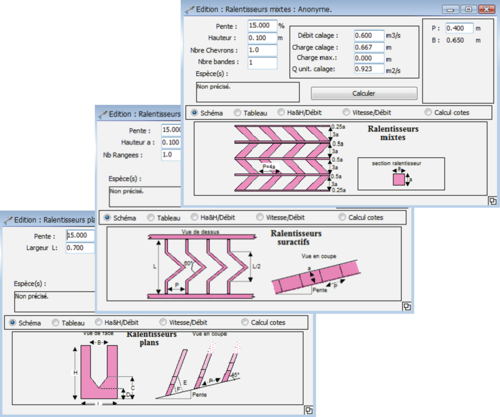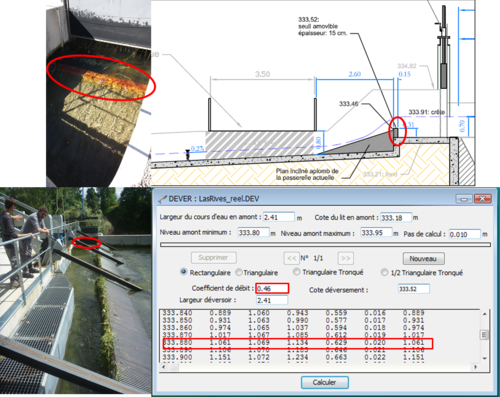Difference between revisions of "Cassiopee"
Bendikhansen (talk | contribs) (Created page with "=Quick summary= file:3d_fish_tracking_installation1.jpg|thumb|250px|Figure 1: 3D fish tracking system (empty of water) installed in the etho-hydraulic flume at VAW of ETH Zu...") |
Bendikhansen (talk | contribs) |
||
| (34 intermediate revisions by 2 users not shown) | |||
| Line 1: | Line 1: | ||
=Quick summary= | =Quick summary= | ||
| − | [[file: | + | [[file:cassiopee_baffle_fishway.png|thumb|500px|Figure 1: Tool to design a baffle fishway in Cassiopée (click to enlarge) (AFB).]] |
| − | + | [[file:cassiopee_las_rives.png|thumb|500px|Figure 2: Example of use of Cassiopée in FIThydro at Las Rives, France. (click to enlarge) (AFB)]] | |
| − | [[file: | + | |
| − | |||
| − | |||
Developed by: French agency for biodiversity (AFB) | Developed by: French agency for biodiversity (AFB) | ||
| + | |||
| + | Date: 1993 | ||
Type: [[:Category:Tools|Tool]] | Type: [[:Category:Tools|Tool]] | ||
| − | |||
| − | |||
=Introduction= | =Introduction= | ||
| − | Cassiopée is a computing software for fish pass designers. It allows studying pool-type fishways, baffle fishways and pre-barrage (for futher information on the different type of fishways please see | + | Cassiopée is a computing software for fish pass designers. It allows studying pool-type fishways, baffle fishways and pre-barrage ([[Nature-like_fishways]], [[Pool-type_fishways]], [[Baffle_fishways]], for futher information on the different type of fishways please see the deliverable 2.1 of the FIThydro project). |
| − | |||
| − | |||
| − | |||
| − | |||
| + | It was developed by Myriad Software Ltd in 1993, under the scientific direction of Michel Larinier and Jean-Pierre Porcher. It runs on Windows systems and two updates were held in 1996 and 2011.The program only addresses users familiar with designing fish passes. In the process of designing a fish pass, the function of Cassiopée is to compute variables characterizing its operating and to present clear and explicit results. | ||
=Application= | =Application= | ||
| − | + | Cassiopée allows the determination of flow and water level for sizing or verifying correct operation for: | |
| + | *pool-type fishways (with plunging or streaming flow notches, submerged orifices, single or double vertical slots) | ||
| + | *baffle fishways (with Denil type, Fatou type, super-active type or chevron type baffles) | ||
| + | *pre-barrages (with rectangular weir, triangular weir or semi-triangular weir) | ||
| − | + | For pool-type fishways, three computing tools allow to determination of the geometry of the basins, given the target flow and drop between pools, water levels in the pools and volumetric dissipated power criteria set by the designer. A fourth tool allows the computation of the size (width and depth) and to altitudinally set the first wall and first basin, given the upstream water level and flow, drop between pools, water levels in the pools and volumetric dissipated power criteria (the altimeter setting of other walls is obtained by substraction from the first wall and the altimeter setting for the basin is based on the drop between pools). | |
| − | + | For pre-barrage, it is possible to associate different types of weir (for example, two rectangular weirs with two levels of crest and a semi-triangular weir). The geometry of pre-barrages can be complex and it is possible to provide flows between basins from upstream to downstream but also between the upstream and any basin. | |
| − | + | For baffle fishways, after setting the geometry, the software allows to determine level-discharge and flow velocity-discharge relationships. It also allows to compute the number of baffles and the elevations of the first and last baffle and corresponding bottom, from upstream and downstream water levels. | |
| − | + | Cassiopée also has 3 computing tools: | |
| − | + | *KIVI: tool to simulate the working conditions of a thin weir (Kindsvater and Cater formula) for submerged flow or not (Villemonte coefficient); | |
| + | *MOODY: tool to compute the discharge or the head loss of a flow in full pipes; | ||
| + | *DEVER: a tool to compute the relationship between upstream water level and discharge transiting at a weir (simple or composed of different spillways with different characteristics). | ||
| − | + | Examples of the software application are given in Figure 1 and 2,. | |
| − | |||
| + | In FIThydro, Cassiopée was used to assess the downstream migration discharges in the downstream migration channels at several French Test Cases (Figure 2). | ||
| + | Based on a topographical survey at the Test Case, the topographic data are entered in the DEVER tool in order to assess the global discharge since it is controlled by a weir. It also allows to refine the discharge coefficient of the control weir and to correct the discharge taking into account the approach velocities of the flow upstream of the weir. | ||
| − | + | =Relevant mitigation measures and test cases= | |
| + | {{Suitable measures for Cassiopee}} | ||
| − | + | =Other information= | |
| − | + | This software is free but not openly accessible. It is distributed after training on fishway design provided by AFB. | |
| − | |||
| − | |||
| − | |||
| − | |||
| − | |||
| − | |||
| − | |||
=Relevant literature= | =Relevant literature= | ||
| − | * | + | *Larinier M., Porcher,J.P. (1996), Cassiopée – Logiciel d’aide au calcul pour le concepteur de passes à poissons – Notice d’utilisation, Conseil Supérieur de la Pêche 1993 |
| − | |||
| − | |||
| + | *Richard,S. (2018). Cassiopée – Logiciel d’aide au calcul pour le concepteur de passe à poisson, Formation continue AFB, Dispositifs de franchissement piscicole, Toulouse 11-15 juin 2018 | ||
| + | *David, L., Dewitte M. (2018) A List of solutions, models, tools and devices, their application range on a regional and overall level, the identified knowledge gaps and the recommendations to fill these. Delivrable 2.1, www.fithydro.eu/wp-content/uploads/2019/07/D2.1-SYGMA.pdf | ||
| − | [[Category: | + | =Contact information= |
| + | Sylvain Richard (AFB) | ||
| + | Dominique Courret (AFB) | ||
| + | [[Category:Tools]] | ||
Latest revision as of 13:34, 26 October 2020
Contents
Quick summary
Developed by: French agency for biodiversity (AFB)
Date: 1993
Type: Tool
Introduction
Cassiopée is a computing software for fish pass designers. It allows studying pool-type fishways, baffle fishways and pre-barrage (Nature-like_fishways, Pool-type_fishways, Baffle_fishways, for futher information on the different type of fishways please see the deliverable 2.1 of the FIThydro project).
It was developed by Myriad Software Ltd in 1993, under the scientific direction of Michel Larinier and Jean-Pierre Porcher. It runs on Windows systems and two updates were held in 1996 and 2011.The program only addresses users familiar with designing fish passes. In the process of designing a fish pass, the function of Cassiopée is to compute variables characterizing its operating and to present clear and explicit results.
Application
Cassiopée allows the determination of flow and water level for sizing or verifying correct operation for:
- pool-type fishways (with plunging or streaming flow notches, submerged orifices, single or double vertical slots)
- baffle fishways (with Denil type, Fatou type, super-active type or chevron type baffles)
- pre-barrages (with rectangular weir, triangular weir or semi-triangular weir)
For pool-type fishways, three computing tools allow to determination of the geometry of the basins, given the target flow and drop between pools, water levels in the pools and volumetric dissipated power criteria set by the designer. A fourth tool allows the computation of the size (width and depth) and to altitudinally set the first wall and first basin, given the upstream water level and flow, drop between pools, water levels in the pools and volumetric dissipated power criteria (the altimeter setting of other walls is obtained by substraction from the first wall and the altimeter setting for the basin is based on the drop between pools).
For pre-barrage, it is possible to associate different types of weir (for example, two rectangular weirs with two levels of crest and a semi-triangular weir). The geometry of pre-barrages can be complex and it is possible to provide flows between basins from upstream to downstream but also between the upstream and any basin.
For baffle fishways, after setting the geometry, the software allows to determine level-discharge and flow velocity-discharge relationships. It also allows to compute the number of baffles and the elevations of the first and last baffle and corresponding bottom, from upstream and downstream water levels.
Cassiopée also has 3 computing tools:
- KIVI: tool to simulate the working conditions of a thin weir (Kindsvater and Cater formula) for submerged flow or not (Villemonte coefficient);
- MOODY: tool to compute the discharge or the head loss of a flow in full pipes;
- DEVER: a tool to compute the relationship between upstream water level and discharge transiting at a weir (simple or composed of different spillways with different characteristics).
Examples of the software application are given in Figure 1 and 2,.
In FIThydro, Cassiopée was used to assess the downstream migration discharges in the downstream migration channels at several French Test Cases (Figure 2). Based on a topographical survey at the Test Case, the topographic data are entered in the DEVER tool in order to assess the global discharge since it is controlled by a weir. It also allows to refine the discharge coefficient of the control weir and to correct the discharge taking into account the approach velocities of the flow upstream of the weir.
Relevant mitigation measures and test cases
| Relevant measures | |
|---|---|
| Baffle fishways | |
| Bottom-type intakes (Coanda screen, Lepine water intake, etc) | |
| Bypass combined with other solutions | |
| Fish guidance structures with narrow bar spacing | |
| Fish-friendly turbines | |
| Fishways for eels and lampreys | |
| Nature-like fishways | |
| Pool-type fishways | |
| Vertical slot fishways | |
| Relevant test cases | Applied in test case? |
| Gotein test case | Yes |
| Las Rives test case | Yes |
| Trois Villes test case | Yes |
Other information
This software is free but not openly accessible. It is distributed after training on fishway design provided by AFB.
Relevant literature
- Larinier M., Porcher,J.P. (1996), Cassiopée – Logiciel d’aide au calcul pour le concepteur de passes à poissons – Notice d’utilisation, Conseil Supérieur de la Pêche 1993
- Richard,S. (2018). Cassiopée – Logiciel d’aide au calcul pour le concepteur de passe à poisson, Formation continue AFB, Dispositifs de franchissement piscicole, Toulouse 11-15 juin 2018
- David, L., Dewitte M. (2018) A List of solutions, models, tools and devices, their application range on a regional and overall level, the identified knowledge gaps and the recommendations to fill these. Delivrable 2.1, www.fithydro.eu/wp-content/uploads/2019/07/D2.1-SYGMA.pdf
Contact information
Sylvain Richard (AFB) Dominique Courret (AFB)

